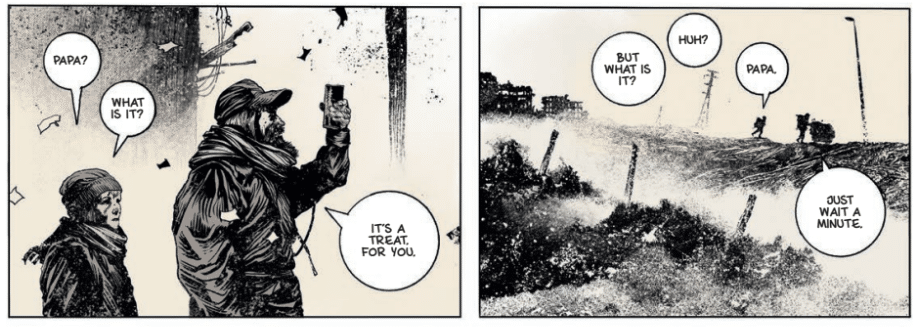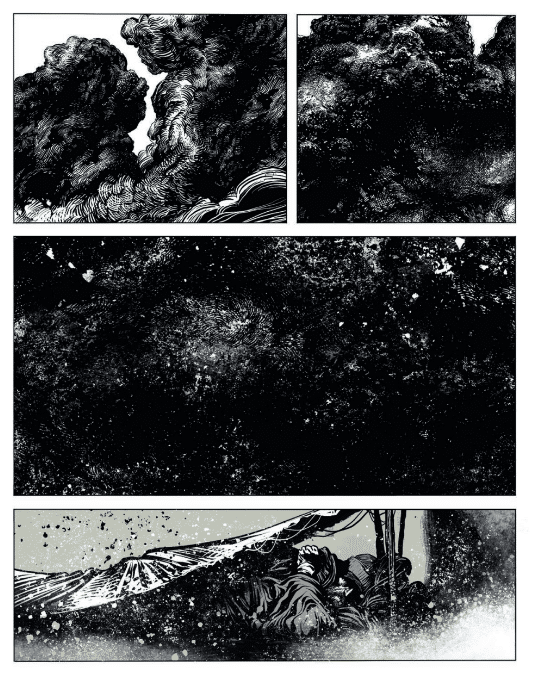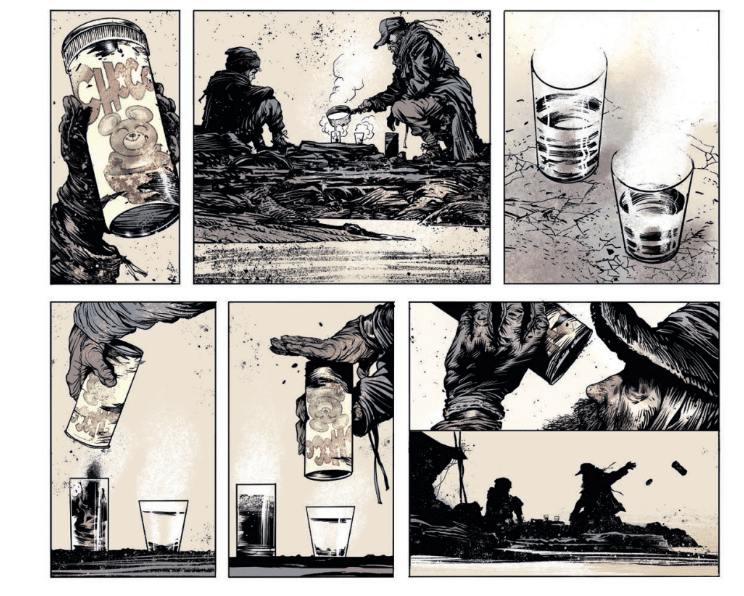The Road
Based on the novel by: Cormac McCarthy
Cartoonist: Manu Larcenet
Publisher: Abrams Books
Publication Date: September 17, 2024
“A man’s odds are to know his mind cause his mind is nothing he has to know it with. He can know his heart, but he don’t want to. Rightly so. Best not to look there. It aint the heart of a creature that is bound in the way that God has set for it. You can find meaning in the least of creatures, but when God made man the devil was at his elbow. A creature that can do anything. Make a machine. And a machine to make the machine. And evil that can run itself a thousand years, no need to tend it.” Cormac McCarthy Blood Meridian
Cormac McCarthy was undeniably one of the greatest novelists of all time, and arguably the greatest American novelist ever. His work was so powerful that you could at once see the whole lineage of American novelists that influenced him, like Faulkner and Joyce, and the entire trajectory of American writers since then trying to capture the direct yet impossible density of his prose. . Once you get into the groove of his style, the polysyndeton sentences and lack of quotation marks, you end up in an almost meditative state flowing from line to line like poetry. McCarthy’s work is challenging, violent, and nihilistic but delivered in the most beautiful way. Nothing can quite fully encapsulate what it’s like to read one of his novels.
Therefore, any attempt to adapt his work is an uphill battle, although this challenge was taken up by several people when McCarthy’s work began to achieve mainstream success with the Border trilogy. All the Pretty Horses became a film in 2000, No Country for Old Men in 2007, and The Road in 2009. But adapting his work is not simply a matter of being “accurate” to the books. The reason No Country for Old Men works is that McCarthy intended it originally as a screenplay, and it’s perhaps his simplest and most straightforward novel. But when you get into the proper breath of his work, novels like Blood Meridian and Suttreeyou find yourself with such dense, formally rigorous prose that adaptation seems impossible. What McCarthy does for language has to first be understood before it can be translated into the language of film or TV or comics, and even then it’s hard to say if there’s any proper equivalence between what he does and what other mediums are capable of.
This is a tall order, and French Cartoonist Manu Larcenet is up to the challenge in this graphic novel adaptation of The Road. The story follows an unnamed father and son who are traversing a post-apocalyptic wasteland in search of provisions. They travel, they camp out, they eat, and then they start the process over again every single day. The reader is never made privy to how the world ended, in the book and in the graphic novel, and instead McCarthy focuses his attention on his familiar themes of humanity’s propensity for violence; carnage without reason that goes beyond any sense of ethics we may have. Like No Country for Old MenMcCarthy’s The Road is friendlier to adaptation than his early work. The narrative is simple and his language is clear, mirroring the vocabulary of his often poor, rural, and world-weary protagonists. The difficulty of reading the novel lies primarily in how much senseless cruelty you can stomach while still maintaining love for your family and faith in humanity as a whole.
Like all of McCarthy’s novels, The Road you have a unique sense of rhythm. The lack of quotation marks means that you have to both pay close attention to the word choice and at the same time fall into the musicality of the back-and-forth exchanges in order to understand who’s speaking. In some moments, McCarthy’s character’s feel indistinguishable as they parrot similar ideas and questions. This is an element that can’t exist in the movie or the audiobook. The task of interpreting and understanding who’s speaking and how they reveal themselves to you is part of the experience. Larcenet does an admirable job of attempting a similar sense of rhythm through the lettering. Rather than depending on the ambiguity of the speaker, he instead plays into short, direct sentences that are displayed as a stacked series of balloons.
Larcenet opens the story with images of the wasteland and smoke that slowly form into the figures of our main characters. Humanity takes shape from the debris of a ruined world, stained with dense, black shadows and sketchy lines blurring the boundary between a person and just another decaying remnant of civilization. These images set the tone of the book and pay homage to how McCarthy reveals his world to the reader in a way that takes full advantage of the comics medium.
Rather than copy and paste McCarthy’s dialogue, Larcenet also chooses to go on for extended sequences with no dialogue, and absolutely no narration. Every page is broken up into large panels that give us the breadth and scope of the terrain that our characters are traveling on, before breaking down into smaller staccato panels. These layouts highlight the nuances of our character’s actions and contrast that with their cosmic insignificance in the face of the challenges that await them.
At your heart, The Road is about the collapse of the social contract and how much you can adhere to the obligations of family while hypocritically abandoning your neighbor. The characters often discuss the idea of being good people, are we the good ones or the bad ones? The Road shares a great deal in common with Blood Meridian. Where one is on the frontiers at the birth of American identity, the other is at the opposite end after its collapse. The cowboys, ranchers, and scalpers are the people who would become the mythic “good ones” that The Road then clings to for meaning. Both The Road and Blood Meridian are futile attempts at finding meaning, when the very actions taken in that search are inseparable from violence and dehumanization.
Larcenet works to problematize these distinctions, good ones and bad ones or society and chaos, by painstakingly humanizing every person we meet along the highway. Every poor, hungry, begging soul appears indistinguishable from our characters. The questions of good guys and bad guys become obscured by the choices we make to hurt others while persevering ourselves, and how quickly those tables can turn when there’s no foundation for our moral sentiments in the form of society.
Larcenet’s greatest achievement here is how he’s able to linger on moments of humanity in his routines, without dialogue to supplement it.
Sequences of sharing food or settling into sleep feel all the more haunting when they’re surrounded by images of the desolated world and with the knowledge of what our characters are doing in the name of survival. These opportunities to separate our characters into their individual paneled prison cells is a welcome enhancement to the story that’s only possible in comics. If McCarthy’s prose is designed to blur the lines between society and humanity, between good and bad, between one person from another, then Larcenet’s paneling forces the reader to overcome the separations, the gutters between panels, to find the humanity that is otherwise lacking. Every interrupted moment, every broken up sequence is one more chance for us to feel the isolation and search, largely in vain, for some semblance of connection on this lonely road.
Larcenet joins the Coen Brothers in the prestigious group of people who are able to translate McCarthy’s worth outside its original media. Larcenet’s telling of The Road is a worthy companion to the novel, and an extension of his own body of work. The care and thought put into the lettering and panels add a new dimension to the thematic work and use the language of comics to properly translate, and not simply repeat, the literary significance of the novel. For fans of McCarthy, Larcenet or newcomers, this is a must buy.
Read more great reviews from The Beat!





